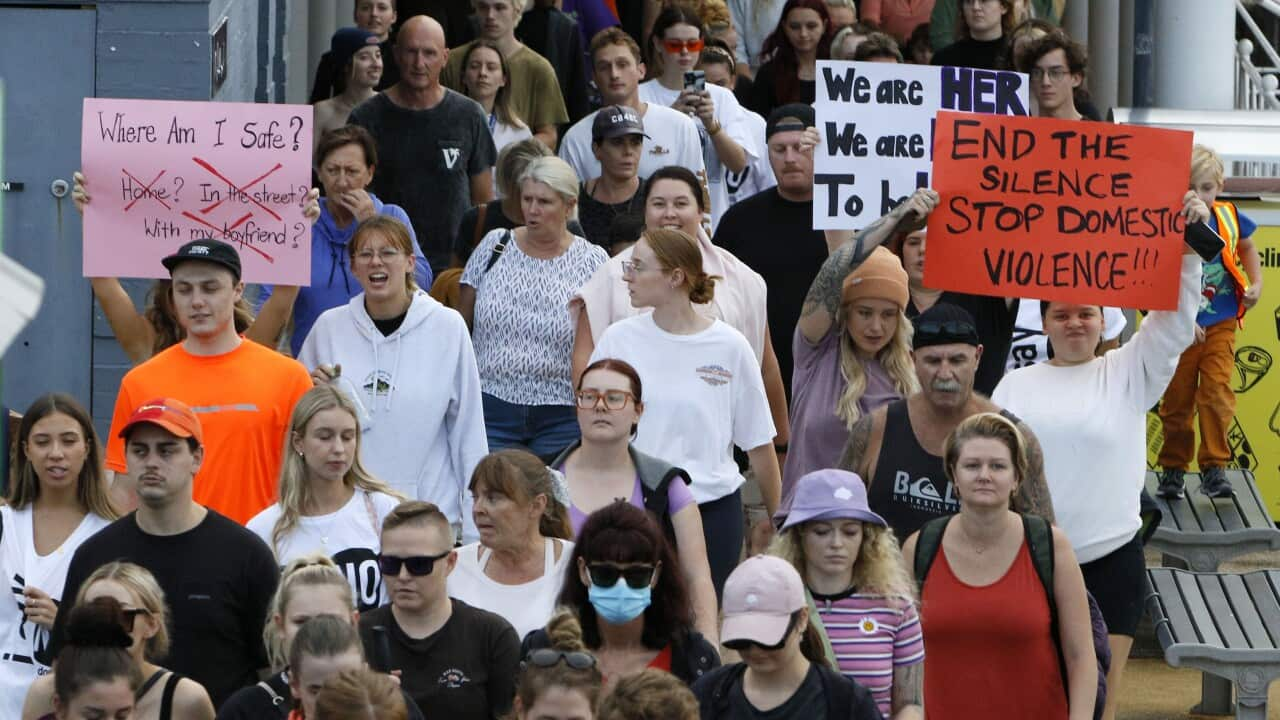

8 min read
This article is more than 1 year old
Explainer
What exactly is — and isn't — sexual consent?
As SBS documentary series Asking For It explores sexual violence in Australia, here are the rules around consent.
Published 20 April 2023 6:09am
Updated 8 May 2023 10:31am
By Emma Brancatisano
Source: SBS News
Image: Saxon Mullins in Asking For It. (Supplied / SBS)
This article contains detailed descriptions of sexual violence.
Saxon Mullins hopes the conversations she wasn’t having about consent when she was younger are being had today.
As a sexual assault survivor — she says she was raped in an alleyway behind a Sydney nightclub by a man she’d met minutes earlier — she’s been among those driving discussions for several years.
But, she says, there's more work to be done.
“If you work in this space, it feels like we’ve been talking about it forever [but] there’s still a lot of people who don’t understand what’s going on, who don’t really see the need,” Ms Mullins told SBS News.
Ms Mullins endured two trials and two appeals, and although the court found she did not consent to sex with the man accused, the judge ultimately ruled he had reasonable grounds for believing she had. He was acquitted in 2017.
The following year, she gave up her anonymity as a sexual assault complainant to share her story with ABC’s Four Corners, and is now taking part in Asking For It, a new SBS documentary series about consent presented by journalist Jess Hill.

Grace Tame, right, an advocate for survivors of child sexual abuse, also appears in Asking for It with journalist Jess Hill. Source: Supplied / SBS
Consent is an agreement between two or more people. When it comes to sex, consent in a social context is understood as a free and voluntary agreement to participate in a specific sexual activity.
Professor Michael Flood, a researcher at the Queensland University of Technology who studies gender, sexuality and interpersonal violence, said there is also an emphasis on 'affirmative consent' - where someone is actively agreeing to or seeking another person’s agreement to that activity.
“What that looks like in practice is, ‘can I do this?’ or ‘does that feel okay?’ Asking, talking and accepting answers is something that individuals should do at every stage of their sexual activity.”
“This is different from negative consent, which is the absence of resistance,” he said.
What that looks like in practice is, ‘can I do this?’ or ‘does that feel okay?- Michael Flood, QUT researcher
Dr Rachael Burgin is a senior lecturer in criminal justice at Swinburne University and chief executive of advocacy organisation Rape and Sexual Assault Research and Advocacy (RASARA).
Consent is “true, informed, meaningful, voluntary, free. It’s sober, it’s not affected by drugs or alcohol, it’s not affected by power dynamics,” she said.
“Everybody has the right to consent or not consent to sex. But in order to proceed, you must have the other person's consent. And that person can't be encouraged, coerced or forced. They can't be threatened.”
What isn't consent?
Professor Flood said sexual violence is defined in the absence of consent.
“When someone is forced or pressured into doing something sexually they don’t want to do, the key thing that’s not happening is their consent,” he said. “The problem is fundamentally consent on the one hand, or coercion on the other.”
in 2021 for young people, parents and educators uses real-life examples to demonstrate circumstances in which consent has not been freely and voluntarily given. These include if a person was physically forced, pressured, intimidated or tricked into sexual activity, or was asleep or unconscious.

An example from RASARA's sexual consent toolkit. Source: Supplied / RASARA
Consent cannot be inferred from social behaviour, such as dancing, flirting or kissing, or agreeing to go back to someone else’s house, the toolkit explains.
Consent must be given every time, meaning agreeing to sex in the past does not infer consent in the future. This includes if you are in a relationship or are married.
Consent can be withdrawn at any time - and one yes isn’t a yes to everything.
“Consent to a kiss isn’t consent to sex. Consent to vaginal penetration is not consent to anal penetration,” Dr Burgin said.
Consent to a kiss isn’t consent to sex.- Dr Rachael Burgin, RASARA
Ms Mullins, who is director of advocacy at RASARA, said consent is commonly misconceived as a “tick-box exercise”, but instead, it's an ongoing conversation.
“Consent is always making sure everyone is engaging and having a good time,” she said.
“You are never done with consent.”

In this scenario, the victim withdrew her consent by asking the perpetrator to stop. Source: Supplied / RASARA
Dr Burgin said the legal definition of consent is more complicated because it differs in every jurisdiction.
“We’re defining consent because we want to establish a crime based on its absence,” she said. “But that means we have multiple jurisdictions deciding what consent is for their community.”
The legal age of consent - at which someone is deemed legally competent to agree to sexual activity - also varies between 16 and 17 across jurisdictions.
In jurisdictions that apply affirmative consent, there is also a requirement to proactively communicate consent, while others do not have this.
Tasmania was the first state to move towards affirmative consent in 2004, while , the ACT and Victoria have recently changed their laws and Queensland has announced it will move to do the same.
An upcoming Senate inquiry into current and proposed sexual consent laws, moved by federal Labor senator Nita Green, will look at inconsistencies between consent laws.
Ms Mullins has been working with RASARA to push for affirmative consent reforms.
This requires a person to show they took active steps to obtain a person’s consent before sex. It’s designed to negate the argument an accused offender had "reasonable grounds" for believing the complainant consented.

An example of how someone in a new relationship might begin an ongoing conversation about having sex. Source: Supplied / RASARA
Professor Flood said people still don't understand affirmative consent and that needs to change.
“Instead, we have a widespread negative standard of consent, where the man should only stop when faced with overt resistance - a woman who is crying, who is saying no,” he said.
“That standard is wrapped up in wider ideas about gender and sexuality.”
He said common social norms get in the way of robust consent, including male sexual entitlement, men taking “initiative” in sex, and the privileging of men's sexual pleasure in relationships.
Around 2.8 million people aged 18 and over have experienced sexual violence (including assault and/or threats) since the age of 15, according to the latest Personal Safety Survey from the Australian Bureau of Statistics (ABS).
That includes about one in five women (22 per cent) and one in 16 men (6.1 per cent) in 2021-22.
In 2021, according to separate ABS data, there were on average around 85 sexual assaults recorded by police per day.
There were six times more female victim-survivors than males.
Sexual violence is “a significant cause of harm, primarily for women and for transgender and gender diverse people,” Dr Burgin said.
The reported statistics are also likely only a fraction of sexual assaults that occur.
According to a 2020 Australian Institute of Health and Welfare report, women who experienced their most recent sexual assault by a male in the last 10 years did not contact police in almost nine in 10 incidents.

Experts say addressing consent is one step towards ending sexual violence in Australia. Source: Supplied / SBS
Under NSW law, sexual intercourse without consent is an offence with a maximum punishment of up to 14 years in prison.
When it comes to ending sexual violence as a form of gender-based violence — a goal — Dr Burgin said consent is a “big part”.
“This is not a new conversation. We’re in another chapter of it,” she said.
“If we want to try and end sexual violence, then we need to be having these conversations at every level, everywhere in our community.”
“For me, it’s always hard to share my story,” Ms Mullins said.
“But if my story can … cause one person to deepen their understanding of consent, of sexual violence, that means it’s all been worth it.”
Asking For It premieres at 8:30pm on Thursday 20 April on SBS and SBS On Demand. The three-part series continues weekly.
It will be subtitled in five languages (Arabic, Simplified Chinese, Traditional Chinese, Korean and Vietnamese) and be available with audio descriptions for blind or vision-impaired audiences.
If you or someone you know is impacted by sexual assault, call 1800RESPECT on 1800 737 732 or visit . In an emergency, call 000.
Correction: This article has been updated to state the latest Personal Safety Survey covers 2021-22.



